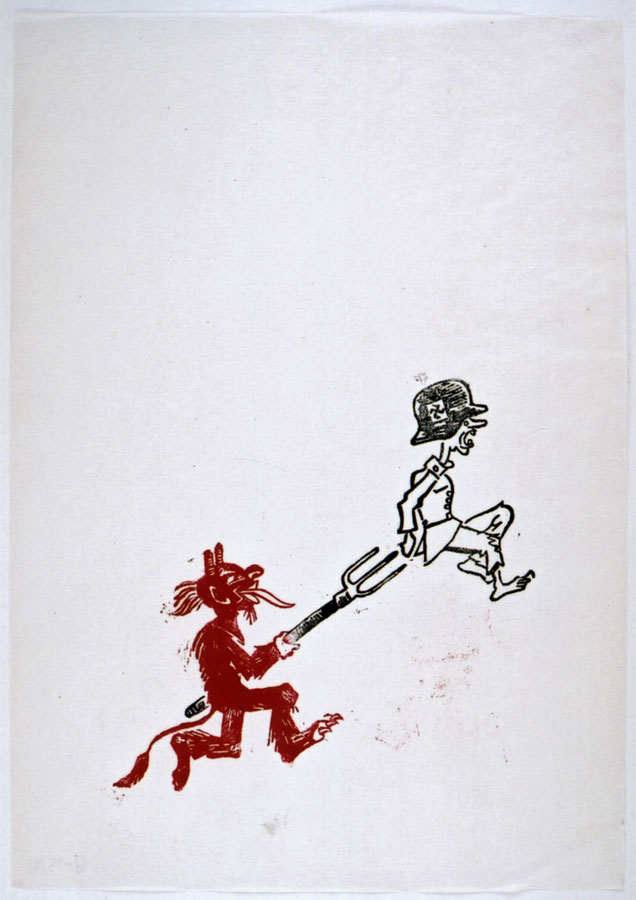How to Think Partisan Art?
 Nikolaj Pirnat, The Devil Stabbing a German (caricature), two-color linocut,
Nikolaj Pirnat, The Devil Stabbing a German (caricature), two-color linocut,
National Museum of Contemporary History
22 December 2009 - 17 January 2010
Mala galerija, Slovenska cesta 35, Ljubljana
The exhibition focuses on what is encompassed by the umbrella term "Partisan art," not with the aim of staging an anthological presentation, but to emphasize the dimension of active thinking, to put forward some new lines along which to think about "Partisan art", and to show the successful combination of art and the Partisan armed struggle in the revolutionary national liberation movement between 1941 and 1945. In the present time of revisionism, the Partisan struggle is, in accordance with the predominant ideology, condemned rather than thought about, willfully divided into "good" and "bad" parts, and somehow violated by all these procedures.
The exhibition casts light on the role of art as part of the Partisan movement. The art produced in relation to the Partisan movement was actively involved in the movement's transformative process by being itself subjected to it: it contributed critically to the articulation of the struggle's symbolic coordinates, which also dictated that art be self-critical. In the anti-fascist struggle, art was forced to face the problematic postulates of the bourgeois conception of art, which structurally made the connection of art and fascism possible on the level of "aestheticizing politics." In the process of social revolution, art had to develop a critique of art as a field established on the basis of the division of labor according to the capitalist social system. This critique also encompassed a polemic inside the Partisan movement.
When dealing with Partisan art as art in a cultural revolution, the question of the possible socially transformative role of art cannot be reduced to the issue of instrumentalizing art for the needs of the struggle, since it was precisely in the context of the struggle that the question of the possibility or impossibility of art as such arose. This is, therefore, a question that remains topical to this day, and actual in the sense Jacques Rancière uses the word: "Something is actual: this means that it is not only 'on the agenda', not only possible or potential, but that it already has a reality, an effectivity now and here." This premise makes the show also an intervention in the conception of contemporary gallery space; it aspires to put it back into the field of critical thought rather than representation, which is increasingly in the foreground in the perception of galleries, museums, and similar (art) institutions. Rather than providing a tunnel-vision view of a frozen past, the exhibition hopes to reactivate the potential of art today, to raise the question of the repetition of the Partisan gesture in art today, under different circumstances.
Conceived by Jože Barši, Miklavž Komelj, Lidija Radojević, and Tanja Velagić, the exhibition is based on Miklavž Komelj's eponymous book recently published by Cf*. It is being staged in collaboration with the Archives of the Republic of Slovenia, the Fine Art Department of the National Museum of Contemporary History, and the Manuscripts Department of the National and University Library.
Related events:
The opening talk by Miklavž Komelj on Tuesday, 22nd December, at 6 p.m. in the Moderna galerija auditorium.
The project has been supported by the Ministry of Culture of the Republic of Slovenia.

Opening hours: Tuesday - Sunday 10.00 - 15.30 & 16.00 - 18.00. Free admission.
Sign up for the MG e-newsletter
Museum of Modern Art
Windischerjeva ulica 2
SI-1000 Ljubljana, Slovenia
Phone
MG+:+386 (0)1 2416 800,
+386 (0)1 2416 834
+MSUM: (0)1 2416 825
Fax: +386 (0)1 2514 120
E-mail: info@mg-lj.si
MG+MSUM
History of the MG
Reconstruction
Opening of the renovated MG
Staff




 MG blog
MG blog
